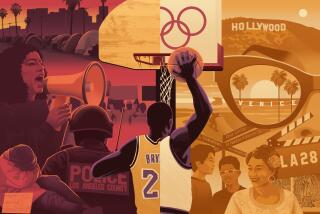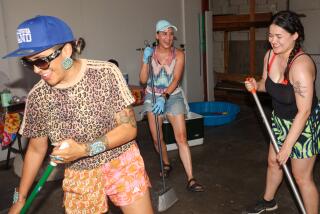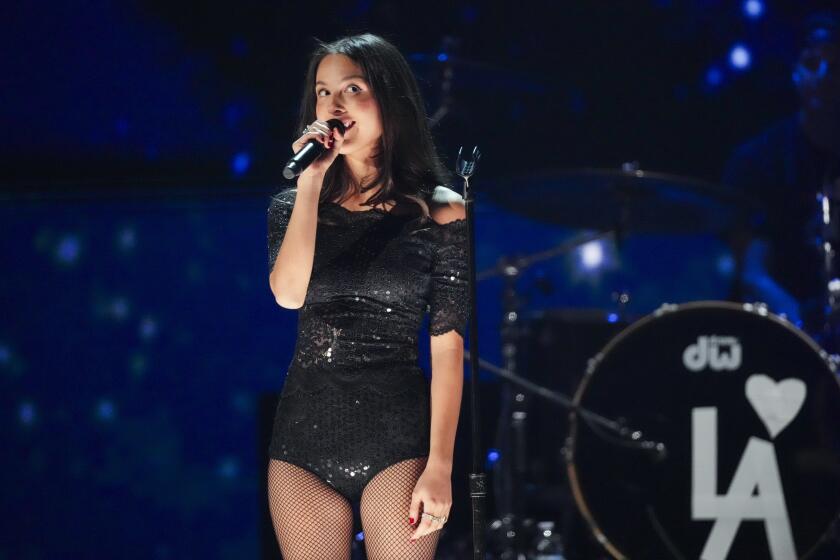A Marketplace of African Authenticity
- Share via
Listen to the drums. They tell of things many people haven’t given much thought to since Alex Haley’s novel “Roots” launched a revival of interest in the origins of the African diaspora nearly a decade and a half ago.
Over the past three years , though, you could hear the drums in Los Angeles, sounding from a genuine African marketplace fashioned in the alleyways adjoining the William Grant Still Arts Center, 2520 West View near Adams Boulevard. On the third weekend in July, August and September, the dank and narrow cavities surrounding the city-run community center were thatched with bamboo and filled with stalls of steaming food and crafts tables buckling under the weight of authentic African wares.
Glimpse of the Continent
Elsewhere in and around the art center, musicians, dancers and folklorists offered a glimpse of myriad artistic influences and retentions traceable to the mother continent. Traditionally garbed storytellers, shamans and showmen cavorted through the winding passages, entertaining the 30,000 or so Angelenos estimated to have attended.
Needless to say, things got a little cramped.
This year, the fourth annual Los Angeles African Marketplace and Cultural Faire is remedying that through what might best be described as a local exercise in continental drift. Today and Sunday , and Aug. 26-27, the Marketplace and Faire will be in full swing across town in the James H. Whitworth Park, at the intersection of La Cienega Boulevard and Fairfax Avenue.
Here, says James Burks, festival organizer and director of the Still Arts Center, the marketplace will make a bid to gain a measure of the stature other arts and ethnic festivals have attained in Los Angeles over the years.
There should be enough African traditions to fill the entire park. Though amply evident in North America, the Caribbean, Europe and the West Indies, the African influence, Burks says, can also be detected as far afield as Australia and South America.
This year’s marketplace will showcase the cultural, culinary and artistic attributes of many of these areas. The marketplace will feature African exotica ranging from jewelry and fine sculpture to traditional costumes, spices and fragrances. Food vendors will offer samplings of the varied fare available in Nigeria, Brazil, Egypt, Ethiopia, Ghana, Jamaica and Belize.
Authentic Music and Dance
Musicians and dancers will demonstrate both authentic African music in addition to African retentions in Afro-Cuban, reggae, blues, gospel, jazz and other neo-African forms. Also scheduled are a Pan-African fashion show, “village games” between competing celebrities, a reggae festival and assorted workshops during the week.
Burks helped establish the first Marketplace because the city lacked, he believed, a vehicle for black expression capable of involving the various Afro-American cultures that have taken root in Los Angeles.
There were, to be sure, a number of organizations and events in Los Angeles that regularly focused on Africa and its influences: the Watts Arts Festival held every August at the Watts Towers Arts Center; the African drum festival held each September; the African mini-marketplace cropping up every third Saturday at Crenshaw Boulevard and Vernon Avenue; activities planned by the Museum of African-American Art, situated inside the Baldwin Hills May Co. on Crenshaw and Martin Luther King boulevards, and by the California Museum of Afro-American Art on Exposition Boulevard.
What the city lacked, however, was a venue where the full confluence of African-related activities and interests could come together and celebrate their vitality. Part of the problem in establishing one, Burks says, was the reluctance of some black Americans to regard themselves in any meaningful way as belonging to such a diaspora.
There is, however, a constituency for this identification, although it is difficult to identify, says Bede Ssensalo, a professor of African literature at Cal State Long Beach and a well-known importer of African wares.
“Generally, interest in Africa among black Americans cuts across social class,” he says. “I find people in the lower and middle economic classes tend to be interested, when presented with something interesting, in their African heritage. The upper middle-class blacks, however, do not always respond as well to, or appreciate, African culture.
“They are, of course, in a precarious position. They understand that they are not white and are discriminated against, but they shun everything that identifies them as black.”
Fragmented Society
Bobby Matos, an Afro-Cuban jazz band leader of Jewish-Puerto Rican descent, believes that the difficulty in fostering a diaspora consciousness within the black community rests in the fragmented nature of American society. For him, the African Marketplace’s greatest achievement has been to bring the various cultural and societal strands within the African-American milieu back in line with each other.
“You get a lot of black Americans here who might not ordinarily listen to samba or Cuban salsa. And Hispanics who may not ever listen to reggae. But it becomes obvious to all of them that the thread running through the music is Africa. It’s amazing to see how positively these groups respond when confronted with the fact that they are all landsmen (a Yiddish term for former fellow countrymen).”
According to Patricia Smith, a dancer and volunteer at the African Marketplace since its inception, merely attending the marketplace is often enough to counter misgivings and increase community awareness of the impressive extent of the African influence. And it goes a long way, she believes, in providing black youngsters with a positive image of their cultural heritage.
Overcoming Misgivings
“I like the excitement and intensity,” she says. “The smells of the food, the fabrics and colors and people--it’s like you’re really in what I imagine an African marketplace would look like.
“You see things you never even realized were connected to Africa,” she says.
Burks says he has largely succeeded in overcoming possible misgivings about a citywide African festival by concentrating on the arts, an approach he feels cannot intimidate anyone--white, black or Asian. Consequently, he says, people from a wide range of ethnic backgrounds have found much that is appealing at the African Marketplace.
“I think we’re trying to show that there’s an economic and artistic and cultural side to a black community that has been here since the city was established. Maybe we can get rid of some of the negatives people think of when they hear South-Central Los Angeles.”
Marketplace Character
Initially, Burks scheduled the African Marketplace on weekends during three consecutive months because he wanted its influence to be longer lasting than other festivals that shine brightly for a week or so and are then forgotten. Though no longer unique in that sense, the Marketplace has developed a character of its own.
Bandleader Matos, who performs at many ethnic festivals, says there is an authenticity and eclecticism at the African Marketplace that is not always evident elsewhere.
“It’s not like Disneyland where they try to re-create the physical aspects of a particular country. Here you get the essence. At other festivals, you may get tents and tables selling anything from velvet paintings to corn dogs. You won’t get corn-dogs at the Marketplace. The food is more likely to be bean pie or American barbecue, or West and North African or Brazilian dishes. To smell all of those spices--it’s a lot different that eating corn dogs on Sunset.”
Turn a Profit
For continental Africans residing in Los Angeles, the Marketplace can be a special treat--an affirmation of cultural pride, a place to be wantonly nostalgic and an opportunity to turn a profit.
Los Angeles, Ssensalo says, has its share of small but close-knit African communities. A native of Uganda who came to America in 1971, Ssensalo says he and about 400 of his countrymen socialize regularly, and can be reached via a master mailing list when, say, an Ugandan head of state or highly placed official comes to town.
There are also sizable communities of Nigerians, Ghanians, Kenyans and other West Africans in Los Angeles. And Southern California also boasts the presence of a thriving white South African community, but they, for obvious political reasons, have not been asked to participate. According to Ssensalo, the African struggle against the South African regime remains the only political issue openly addressed--mainly through information dispersal--at the Marketplace.
Tourist Attraction
Meanwhile, there is evidence that the City of Los Angeles, which in essence is responsible for the African Marketplace and Cultural Faire insofar as it is responsible for the Still Arts Center, may become inclined to view it as a potential tourist attraction.
Tenth District City Councilman Nate Holden has announced his willingness to assist the Marketplace and Faire. Some believe that, in time, it can’t help but win a place within the tourism market alongside such yearlong attractions as Chinatown, Little Tokyo, Farmers Market and the Alpine and Polynesian villages.
Its appeal?
“It’s a little like visiting several countries at once,” says bandleader Matos. “That’s a trip in itself.”
More to Read
The biggest entertainment stories
Get our big stories about Hollywood, film, television, music, arts, culture and more right in your inbox as soon as they publish.
You may occasionally receive promotional content from the Los Angeles Times.










